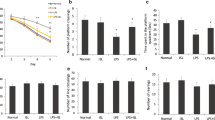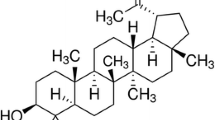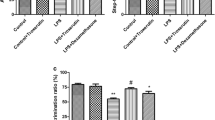Abstract
Mangiferin has been extensively applied in different fields due to its anti-inflammatory properties. However, the precise mechanism used by mangiferin on lipopolysaccharide (LPS)-induced inflammation has not been elucidated. Here, we discuss the potential mechanism of mangiferin during a LPS-induced brain injury. Brain injury was induced in ICR mice via intraperitoneal LPS injection (5 mg/kg). Open- and closed-field tests were used to detect the behaviors of mice, while immunoblotting was performed to measure the expression of interleukin-6 (IL-6) and cystathionine-b-synthase (CBS) in the hippocampus after mangiferin was orally administered (p.o.). Mangiferin relieved LPS-induced sickness 6 and 24 h after LPS injection; in addition, this compound suppressed LPS-induced IL-6 production after 24 h of LPS induction as well as the downregulation of LPS-induced CBS expression after 6 and 24 h of LPS treatment in the hippocampus. Therefore, mangiferin attenuated sickness behavior by regulating the expression of IL-6 and CBS.





Similar content being viewed by others
References
Amazzal L, Lapotre A, Quignon F et al (2007) Mangiferin protects against 1-methyl-4-phenylpyridinium toxicity mediated by oxidative stress in N2A cells. Neurosci Lett 418:159–164
Bhatia HS, Candelario-Jalil E, de Oliveira AC et al (2008) Mangiferin inhibits cyclooxygenase-2 expression and prostaglandin E2 production in activated rat microglial cells. Arch Biochem Biophys 477:253–258
Chen Z, Jalabi W, Shpargel KB et al (2012) Lipopolysaccharide-induced microglial activation and neuroprotection against experimental brain injury is independent of hematogenous TLR4. J Neurosci 32:11706–11715
Choi SH, Joe EH, Kim SU et al (2003) Thrombin-induced microglial activation produces degeneration of nigral dopaminergic neurons in vivo. J Neurosci 23:5877–5886
Cohen N, Stolarsky-Bennun M, Amir-Kroll H et al (2008) Pneumococcal capsular polysaccharide is immunogenic when present on the surface of macrophages and dendritic cells: TLR4 signaling induced by a conjugate vaccine or by lipopolysaccharide is conducive. J Immunol 180:2409–2418
Frenois F, Moreau M, O’Connor J et al (2007) Lipopolysaccharide induces delayed FosB/DeltaFosB immunostaining within the mouse extended amygdala, hippocampus and hypothalamus, that parallel the expression of depressive-like behavior. Psychoneuroendocrinology 32:516–531
Gong X, Zhang L, Jiang R et al (2013) Anti-inflammatory effects of mangiferin on sepsis-induced lung injury in mice via up-regulation of heme oxygenase-1. J Nutr Biochem 24:1173–1181
Gottlieb M, Leal-Campanario R, Campos-Esparza MR et al (2006) Neuroprotection by two polyphenols following excitotoxicity and experimental ischemia. Neurobiol Dis 23:374–386
Hauss-Wegrzyniak B, Lukovic L, Bigaud M et al (1998) Brain inflammatory response induced by intracerebroventricular infusion of lipopolysaccharide: an immunohistochemical study. Brain Res 794:211–224
Jung K, Lee B, Han SJ et al (2009) Mangiferin ameliorates scopolamine-induced learning deficits in mice. Biol Pharm Bull 32:242–246
Kentner AC, Takeuchi A, James JS et al (2008) The effects of rewarding ventral tegmental area stimulation and environmental enrichment on lipopolysaccharide-induced sickness behavior and cytokine expression in female rats. Brain Res 1217:50–61
Kimura H (2000) Hydrogen sulfide induces cyclic AMP and modulates the NMDA receptor. Biochem Biophys Res Commun 267:129–133
Kwiatkoski M, Soriano RN, Araujo RM et al (2013) Hydrogen sulfide inhibits preoptic prostaglandin E2 production during endotoxemia. Exp Neurol 240:88–95
Leiro J, Arranz JA, Yanez M et al (2004) Expression profiles of genes involved in the mouse nuclear factor-kappa B signal transduction pathway are modulated by mangiferin. Int Immunopharmacol 4:763–778
Li L, Bhatia M, Zhu YZ, Zhu YC et al (2005) Hydrogen sulfide is a novel mediator of lipopolysaccharide-induced inflammation in the mouse. FASEB J 19:1196–1198
Li T, Zhao B, Wang C et al (2008) Regulatory effects of hydrogen sulfide on IL-6, IL-8 and IL-10 levels in the plasma and pulmonary tissue of rats with acute lung injury. Exp Biol Med (Maywood) 233:1081–1087
Maeda S, Nakatsuka I, Hayashi Y et al (2008) Heme oxygenase-1 induction in the brain during lipopolysaccharide-induced acute inflammation. Neuropsychiatr Dis Treat 4:663–667
Marquez L, Garcia-Bueno B, Madrigal JL et al (2012) Mangiferin decreases inflammation and oxidative damage in rat brain after stress. Eur J Nutr 51:729–739
Matsumura K, Kaihatsu S, Imai T et al (2000) Cyclooxygenase in the vagal afferents. Is it involved in the brain prostaglandin response evoked by lipopolysaccharide? Auton Neurosci 85:88–92
Moore PK, Bhatia M, Moochhala S (2003) Hydrogen sulfide: from the smell of the past to the mediator of the future? Trends Pharmacol Sci 24:609–611
O’Connor JC, Lawson MA, Andre C et al (2009) Lipopolysaccharide-induced depressive-like behavior is mediated by indoleamine 2,3-dioxygenase activation in mice. Mol Psychiatry 14:511–522
Pardo Andreu GL, Maurmann N, Reolon GK et al (2010) Mangiferin, a naturally occurring glucoxilxanthone improves long-term object recognition memory in rats. Eur J Pharmacol 635:124–128
Pinto MM, Sousa ME, Nascimento MS (2005) Xanthone derivatives: new insights in biological activities. Curr Med Chem 12:2517–2538
Pollmacher T, Haack M, Schuld A et al (2002) Low levels of circulating inflammatory cytokines-do they affect human brain functions? Brain Behav Immun 16:525–532
Rivest S (2003) Molecular insights on the cerebral innate immune system. Brain Behav Immun 17:13–19
Shaw KN, Commins S, O’Mara SM (2001) Lipopolysaccharide causes deficits in spatial learning in the watermaze but not in BDNF expression in the rat dentate gyrus. Behav Brain Res 124:47–54
Sparkman NL, Kohman RA, Scott VJ et al (2005) Bacterial endotoxin-induced behavioral alterations in two variations of the Morris water maze. Physiol Behav 86:244–251
Xiao L, Lan A, Mo L et al (2012) Hydrogen sulfide protects PC12 cells against reactive oxygen species and extracellular signal-regulated kinase 1/2-mediated downregulation of glutamate transporter-1 expression induced by chemical hypoxia. Int J Mol Med 30:1126–1132
Yamaguchi S (2004) Preventive effects of anti-inflammatory drugs (non steroidal anti-inflammatory drugs) on Alzheimer disease. Nihon Rinsho 62(Suppl):479–483
Yan J, Teng F, Chen W et al (2012) Cystathionine beta-synthase-derived hydrogen sulfide regulates lipopolysaccharide-induced apoptosis of the BRL rat hepatic cell line in vitro. Exp Ther Med 4:832–838
Acknowledgments
This work was supported by the National Natural Science Foundation of China (31100762, 81371300), the Education Departmental Natural Science Research Funds of Jiangsu Provincial Higher School of China (11KJB310013, 13KJB310021), the Key Laboratory of Brain Disease Bioinformation of Jiangsu Province (Jsbl1102), the Foundation of President of Xuzhou Medical College (2012KJZ06, 2011KJ11), and the Qing Lan Project of Jiangsu Province.
Conflict of interest
No conflict of interest.
Author information
Authors and Affiliations
Corresponding authors
Additional information
Yan-Yan Fu, Fang Zhang, and Lei Zhang contributed equally to this work.
Rights and permissions
About this article
Cite this article
Fu, YY., Zhang, F., Zhang, L. et al. Mangiferin Regulates Interleukin-6 and Cystathionine-b-Synthase in Lipopolysaccharide-Induced Brain Injury. Cell Mol Neurobiol 34, 651–657 (2014). https://doi.org/10.1007/s10571-014-0039-8
Received:
Accepted:
Published:
Issue Date:
DOI: https://doi.org/10.1007/s10571-014-0039-8




